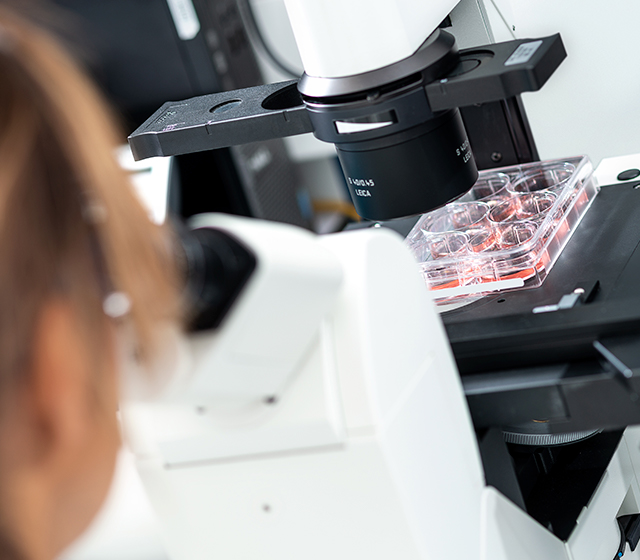Neuroscience
Alzheimer’s Disease Assay Kits
Alzheimer’s disease (AD) is a progressive neurodegenerative disorder that is the seventh leading cause of death and the most common cause of dementia globally.
The identifiers of AD are the presence of neurite or senile plaques and neurofibrillary tangles, surrounded by damaged neurons. Beta Amyloid 1-42 is a major component of these plaques, and many studies suggest that it may form toxic oligomers (Aβos) and fibrils. The pathogenic β-Amyloid 1-42 found in AD or the non-pathogenic peptide P3 (healthy individuals) are processed from the Amyloid Precursor Protein by Secretases (α, β, γ).
In healthy individuals the levels of beta amyloid are maintained through tightly controlled biosynthesis and clearance mechanisms, which is lacking in Alzheimer’s disease. Recent studies suggest that the prevention of Aβ build-up may be better controlled through its increased degradation rather than inhibition of its synthesis. Therefore, beta-amyloid degrading enzymes (ADEs) such as Neprilysin, Endothelin-converting enzyme-1, Insulin-degrading enzyme, and Glutaminyl Cyclase have become valuable targets of Alzheimer’s disease drug development.
Prevention or interference of Beta-Amyloid aggregation or fibrillation is also of high interest in Alzheimer’s disease research and drug discovery. Our SensoLyte® Thioflavin T β-Amyloid Aggregation Kits are ideal for studying beta amyloid fibrillation kinetics or screening for aggregation inhibitors.
Multiple Sclerosis (MS)
Multiple sclerosis (MS) is the leading cause of nontraumatic neurological disability in young adults and affects approximately 2.8 million people worldwide. During MS progression, autoimmune antibodies are raised to certain myelin components, including myelin oligodendrocyte glycoprotein (MOG), myelin basic protein (MBP) and myelin proteolipid Protein (PLP), which results in demyelination of axons and neurodegenerative disease of the central nervous system.
The severity of MS symptoms vary but includes numbness, tingling, mood changes, memory problems, pain, fatigue, blindness and/or paralysis. The epidemiology of Multiple Sclerosis suggest that low serum levels of vitamin D, smoking, childhood obesity and infection with the Epstein–Barr virus may be factors in disease development.
Induced Experimental Autoimmune Encephalomyelitis (EAE) is often employed as an in vivo animal model for use in Multiple Sclerosis research. It is typically induced in rat or mice models, by immunization with MOG, MBP or PLP proteins or key peptide fragments.
Measurement of anti-MOG and anti-PLP autoantibodies in serum is key to confirming proper EAE induction and AnaSpec has pioneered development of the first ELISA kits for this purpose. Our MOG kits are flexible, as they can detect autoimmune IgGs against mouse/rat MOG (35-55), rat MOG (1-125), mouse MOG (1-125) or human MOG (1-125). The latter is adapted to either human or mouse samples.
FRET substrates
FRET occurs between a peptide tagged to a donor and an acceptor when placed within 10-100Å of each other resulting in the donor’s excitation fluorescence to be quenched by the acceptor. Enzymatic hydrolysis of the peptide results in recovery of the donor fluorescence following spatial separation of the donor and acceptor upon energy transfer.
| Dye (donor) | Quencher (acceptor) | Donor Ex/Em | |
| SensoLyte® 390 | Mca | Dnp |
•
325/393 nm |
|---|---|---|---|
| SensoLyte® 490 | EDANS | DABCYL |
•
340/490 nm |
| SensoLyte® 520 | 5-FAM or HiLyte™ Fluor 488 | QXL®520 |
•
494/521 nm |
| SensoLyte® 570 | 5-TAMRA | QXL®570 |
•
547/574 nm |
Fluorogenic substrates
These substrates do not require a quencher and contain a C-terminal dye that does not fluoresce until it is cleaved from the peptide (fluorescent form of dye is released).
| Dye (donor) | Donor Ex/Em | |
| SensoLyte® AMC | AMC |
•
351/430 nm |
|---|---|---|
| SensoLyte® AFC | AFC |
•
382/480 nm |
| SensoLyte® Rh110 | Rh110 |
•
501/527 nm |
